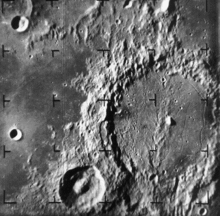Alphonsus (crater)
|
|
Template:Lunar crater Alphonsus is an ancient impact crater on Earth's Moon that dates from the immediate post-Nectarian era. It is located on the lunar highlands on the eastern end of Mare Nubium, west of the Imbrian Highlands, and slightly overlaps the Ptolemaeus crater to the north. The surface is broken and irregular along this boundary. The outer walls are slightly distorted in form and possess a somewhat hexagonal form. To the northwest is the smaller Alpetragius crater.
A low ridge system of deposited ejecta bisects the crater floor, and includes the steep central peak designated Alpha (α) Alphonsus. This pyramid-shaped formation rises to a height of 1.5 km above the interior surface. It is not volcanic in origin, but rather is made of anorthosite like the lunar highlands.

The floor is fractured by an elaborate system of rilles and contains three smaller craters surrounded by a symmetric darker halo. These dark-halo craters are cinder-shaped and are believed by some to be volcanic in origin, although others think they were caused by impacts that excavated darker mare material from underneath the lighter lunar regolith.
Alphonsus crater was one of the primary alternative landing sites considered for both the Apollo 16 and the Apollo 17 missions. The Ranger 9 probe impacted in Alphonsus crater, a short distance to the northeast of the central peak.
| Contents |
Transient lunar phenomenon
Alphonsus was one of the sites noted for transient lunar phenomenon, as glowing red-hued clouds had been reported emanated from the crater. On October 26, 1956, the lunar astronomer Dinsmore Alter noted some blurring of the rilles on the floor of Alphonsus in the photographs he took in violet light. The same blurring did not occur in the infrared photographs he took at the same time. However few professional astronomers found this evidence of volcanic activity on the Moon very convincing.
One astronomer who was intrigued by this evidence was Nikolai A. Kozyrev, from the Soviet Union. In 1958 he observed the formation of a mist-like cloud within the Alphonsus crater. The spectrum of the area had been measured at this time, and displayed indications of carbon matter, possibly C2 gas. He believed this to be the result of volcanic or related activity. However no evidence for this phenomenon has been found from lunar missions, and the emission results have never been confirmed.
Interior craters
Five tiny craters in the northeastern part of Alphonsus' interior floor have been assigned names by the IAU. These are listed in the table below.
| Crater | Longitude | Latitude | Diameter | Name source |
|---|---|---|---|---|
| Chang-Ngo | 12.7° S | 2.1° W | 3 km | Chinese feminine name |
| José | 12.7° S | 1.6° W | 2 km | Spanish masculine name |
| Monira | 12.6° S | 1.7° W | 2 km | Arabic feminine name |
| Ravi | 12.5° S | 1.9° W | 2.5 km | Indian masculine name |
| Soraya | 12.9° S | 1.6° W | 2 km | Persian feminine name |
Satellite craters
By convention these features are identified on Lunar maps by placing the letter on the side of the crater mid-point that is closest to Alphonsus crater.
| Alphonsus | Latitude | Longitude | Diameter |
|---|---|---|---|
| A | 14.8° S | 2.3° W | 4 km |
| B | 13.2° S | 0.2° W | 24 km |
| C | 14.4° S | 4.8° W | 4 km |
| D | 15.1° S | 0.8° W | 23 km |
| G | 12.3° S | 3.3° W | 4 km |
| H | 15.6° S | 0.5° W | 8 km |
| J | 15.1° S | 2.5° W | 8 km |
| K | 12.5° S | 0.1° W | 20 km |
| L | 12.0° S | 3.7° W | 4 km |
| R | 14.4° S | 1.9° W | 3 km |
| X | 15.0° S | 4.4° W | 5 km |
| Y | 14.7° S | 1.8° W | 3 km |
